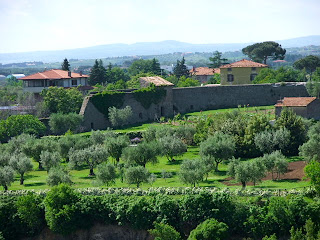The Thursday after we returned from our long excursion North, we headed a little ways north, off to Bomarzo and Viterbo with one of our professors. Our other professor was on his way to Michigan for four days to run a medieval history conference. Whew! We started in Bomarzo where we would see the Park of Monsters, more appropriately known as the Sacred Forest, according to our guide. The park was built in the 16th century by Pier Francesco Orsini (a member of the Orsini family, a powerful Italian family who was also important in Rome). Its purpose was to astonish its visitors, but not necessarily to please them. The park was basically a big forest with trails and a stream. Hidden within the natural habitat are large statues of animals and characters from mythology. We spent a few hours wandering through the park, enjoying the various statues and just being in the woods on a beautiful day. It was a sunny day, and the light coming through the trees cast wonderful shadows throughout the park (it made the lighting for pictures hard, but it was gorgeous being there). In addition, the cottonwood trees were shedding, and so it felt like it was snowing cotton.
 |
| The entrance to the park |
 |
| I found this little guy on one of the rocks |
 |
| Isn't he pretty? |
 |
| The leaning house |
 |
| Inside the leaning house--it was dizzying |
 |
| It's raining cotton! |
 |
| The most famous statue in the park--you can go inside his mouth, and there is a reasonably sizable room |
Our next stop was Villa Lante in Bagnaia near Viterbo (stop #3). The villa was also built in the 16th century, and has one of the most beautiful gardens I have ever seen. The gardens are built on a slope, and our professor told us to walk all the way to the top of the gardens without really looking at anything. The reason for this is that the gardens were designed strategically: the top part of the gardens were left wild and as you move down the hill, they become more manicured, until you reach the bottom where they are laid out perfectly symmetrically and geometrically. The gardens wonderful, and in particular they had a wonderful water installation that ran down the middle of the gardens.
 |
| A tower in Bagnaia |
 |
| A fountain at the bottom of the gardens |
 |
| The water installation running down the middle of the gardens |
 |
| I found a hollow tree! |
Our final stop of the day was in Viterbo, a smallish medieval city north of Rome. During the 12th and 13th centuries, Viterbo was important to the papacy, and in 1243 became a papal city. Viterbo was then the site of five papal elections and the residence of seven popes. This was a period when the popes were struggling to assert their authority over Rome, and so Viterbo was often seen as the preferred residence because it was near Rome, but not right in the heart of the controversy. The historic city center is still surrounded by the medieval walls which were built during the 11th and 12th centuries. Our visit to Viterbo was fun because we had now seen multiple medieval cities and were starting to get a feel for them. The arches, stonework, and piazzas were feeling more and more familiar. It was also interesting that a town that feels quite small and compact today was once an important center of religion and politics for the Catholic Church.
 |
| A view of the papal residence |
 |
| A view from the papal residence |
 |
| This town had beautiful archways |




































No comments:
Post a Comment